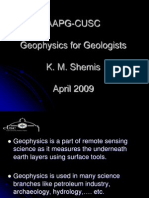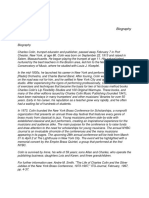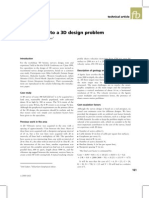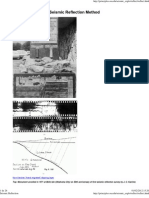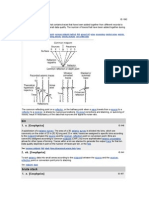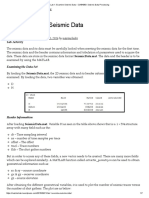3D Seismic Geometery
3D Seismic Geometery
Uploaded by
mikegeo123Copyright:
Available Formats
3D Seismic Geometery
3D Seismic Geometery
Uploaded by
mikegeo123Copyright
Available Formats
Share this document
Did you find this document useful?
Is this content inappropriate?
Copyright:
Available Formats
3D Seismic Geometery
3D Seismic Geometery
Uploaded by
mikegeo123Copyright:
Available Formats
Impact of Irregularities of 3D Seismic Geometry on Subsurface Imaging
Singh U. P.*, Ram Kumar, Barve B. K., Dr. Vishwanathan S.
ONGC, Vadodra
Summary
3D seismic data acquisition brought a sea change in subsurface imaging. The bridge between geology and seismic is P/S wave velocity of different subsurfaces/lithology. The technique has acquired prime importance due to its inherent strength of determining seismic velocity/amplitudes of the different medium. Lithological variations estimations is possible due to proper Vp/Vs ratio or either velocity alone. Success of advance seismic studies solely depends on accurate subsurface mapping. 3D seismic subsurface image is biased to a great extent by the acquisition geometry, as it affects lateral & vertical velocities. Thus a proper evaluation of the influence of the acquisition geometry on image quality, in areas with complex geology, needs to be carried out. The acquisition geometry footprint is the cumulative effect of azimuthal fold variations across the near offsets, source-receiver directivity, and subsurface illumination irregularities. The ideal 3D acquisition geometry called full 3D is the one in which the whole sub-surface area should be covered with regular source positions, and recorded in receiver positions covering the whole acquisition area. Each receiver position is to be covered by source position as well. In 3D seismic survey the choices of acquisition geometry is governed by geological objectives. The optimization of acquisition geometry arises out of resource constraints / cost. The impact of offsets, azimuths, inherent acquisition footprint needs to be understood while optimizing these acquisition parameters/geometry. Obstructions, environmental objectives, economic constraints and many other factors cause irregularity and sparse data sampling. This needs to be studied before geometry optimization as demography is altering at a rapid pace with urbanization. The irregularities are observed in the form of variations in the fold coverage, irregular offset which can manifest itself as an acquisition footprint on pre-stack data or even the stacked image. This study deals with the various irregularities introduced by the choice of geometry. Thus assessing the environmental / logistic /economic resource constraints, design of geometry should not sacrifice the basic objective of the 3D survey.
Introduction
The CDP technique and rapid advances in seismic has brought the seismic exploration, at forefront out of all the exploration methods. This prominence can be attributed to its inherent strength in extracting seismic velocities which immensely facilitates in understanding the heterogeneity of the subsurface. Subsequent advances in data acquisition utilized seismic velocities to a large extent for imaging the subsurface. Better lithological predictions have also become possible by proper estimation of Vp/Vs. Thus the success of advance seismic studies solely depends on accuracy of seismic velocity estimations which in turn are dependent on offsets and foldage of seismic data recorded in 2D or 3D methods. For any given subsurface mapping, the design of 3D acquisition geometry is characterized by a particular distribution of fold, offset and azimuth. Over the last decade the 3D acquisition geometries used are the outcome of the optimization process of geophysical operation and cost estimates.
Irregular spatial distribution is very common with 3D seismic surveys. Ideally a 3D survey is acquired on a regular 4-D grid x, y, h, . The spatial distribution of traces in this subset is highly irregular in general. Even if it is ensured that midpoints are regularly distributed, there is always an irregularity in the offset and azimuths. Added to this the prevailing logistics further reduces the above subset of the 4-D space. Traces with different offset are oriented in various directions within a bin. Distribution of these traces varies from bin to bin. All this leads to improper sampling of the full wave field. Thus in 3D it is very difficult to maintain recording of all the offsets in the survey area uniformly. Hence any 3D seismic survey can have an acquisition footprint. Our problem is to determine whether we have one and if so, whether we can recognize it, how severe it is and, most importantly, what we can do about it. This paper starts with a description of the conventional 3D geometry design and its associated rationale. Then a review is made regarding the various irregularities
(140)
6th Internatiuonal Conference & Exposition on Petroleum Geophysics "Kolkata 2006"
introduced in the different optimized geometries. Finally an effort is made to discuss the optimization of various irregularities introduced without sacrificing the final goal of illuminating the target reflector and its associated faults.
Conventional 3-D seismic survey design
The conventional approach to 3-D survey design started by extending the 2-D stack-array approach put forward by N. Anstey to 3-D. In the stack array approach, the combination of geophone array and stack (together called the stack array) forms a very good means of suppressing the ground roll. In land data acquisition the pre-requisite for the stack-array approach was equal sampling of shots and receivers for centre spread. This approach results in common midpoints with a regular distribution of offsets. The application of this approach to the design of 3-D geometry, results in emphasis on a regular offset distribution in each bin with minimum scattering of midpoints in a bin. This was achieved in 3-D by use of parallel geometries. Most of these geometries comprise of an ensemble of parallel line of receivers at fixed distances and parallel lines of sources also at regular intervals. The source lines are usually arranged parallel, perpendicular or at an angle with respect to the receiver lines. Regular sampled source lines parallel to receiver lines produces a regularly sampled midpoints with a regular (absolute) offset distribution. The best outcome of this approach was the slant geometry (double zigzag). At this point of time orthogonal geometries were discarded as they produced highly irregular offset distribution, primarily because the receiver lines were placed close to each other. Later on it was realized that in land, orthogonal geometry has considerable advantages in efficiency over parallel geometry. Aspect ratio started playing a major role in the choice of the geometry. However, with limited no. of channels available earlier the aspect ratio will be small (max. X - line offset was much smaller than max. in - line offset).
are related to observed first break times for each refracting layer. Lack of coupling caused by regular geometries once again leads to smoothening requirement and the possibility of bulk shifts from one group of CMPs to another. Thus for each refractor, it is essential to have coupling in the in-line and cross-line directions. This implies that the cross-line offsets should be comparable to that of the in-line offsets so that the deepest refractors are sampled equally in all the directions.
Irregularity in offset distribution
Offset distribution is an important attribute in data acquisition. A regular distribution of offsets provides a good estimate of velocity and residual statics. The quality of stack and migration in seismic section is highly sensitive to the velocity estimates. Thus a good offset distribution is key to better imaging of the subsurface. However, in practice, it is extremely difficult to acquire a 3D data with the regular offset distributions. All swath geometry has its associated inherent offset distribution pattern. The data acquisition percentage with regular geometries varies from area to area. The demographic setup of the area plays an important role in irregularities of trace offsets. This irregularity in offset, azimuth and non redundancy space is causative for deviation from planned survey. Irregularity in offset domain has two components namely the redundancy and the offset gap in the offset spectrum. The deviation from the regular distribution of offset can be defined in the form of a coefficient Cd measuring the regularity of bin offsets (as defined in Geoland software documentation) as follows:
Coefficient of regularity of offset
Cd = 100 x (1-d /(e kn) where Cd = Coefficient of regularity of offset n = reference fold e = interval between trace in cdp domain Where if the sequence of offsets is Di Ii is increment of offsets = Di Di-1 d is the standard deviation of Ii k = (Dmax Dmin) / ne for Dmax Dmin < ne =1 for Dmax Dmin > ne Dmax. & Dmin. are the boundary limits of analysis in offset space. This factor is independent of the width of the range of selected offsets and of the definition of acquisition spread.
Statics Coupling
Static Coupling requirement at processing stage is due to derivation of converging residual statics solutions based on the redundancy of source and receiver positions. One simple way to solve this is to use techniques like flexi bin (Cordsen). Processing tricks, such as smoothening the CMP average during Gauss-Seidel iteration, still leaves the long wavelength component unsolved. The only alternative left is to resort to 3-D refraction statics programs. Most refraction statics algorithms involve matrix solutions where shot and receiver delays and velocity (slowness) at CMPs
(141)
It is evident that the regularity in offset distribution is dependent on reference fold and the offset class. It is also equally important to note that the selection of reference fold and offset class may change the value of regularity.
ii) Non availability of source / receiver positions due to obstacles:
The common practice is to displace shots and receivers to alternative positions chosen to maintain, as much as possible, the uniformity of fold and the regularity of offsets and azimuth distribution. All sources and receivers are considered equally important to the subsurface image, which is probably not a good idea in general. The presence of large obstacles can be incorporated into the design procedure and alternative source and receiver locations chosen to optimize the regularity of the illumination as opposed to the regularity of fold, offset or azimuth distributions as is standard practice. It may very well happen that some shots in the excluded area (Fig 2) turn out not contributing significantly to the critical parts of the image and so can be simply ignored if they are difficult to replace. On the other hand, it may turn out that those shots are critical and then we have compelling reasons to make a stronger effort to acquire them. This irregularity can be seen in the minimum offset map (Fig 3) or in the shallow time slices.
Irregularity in Azimuth distribution
Azimuth distribution plays a vital role while carrying out azimuthal velocity and is an important attribute in subsurface imaging. The coefficient Ca measuring regularity of the azimuths in a bin can be defined similar to irregularity in offset (as defined in Geoland software documentation) as Ca = 100 * ( 1- * kn)/360) Where Ca = Coefficient of regularity of Azimuth Ca = 100 for a regular distribution Ca = 0 for an irregular distribution (all azimuths identical except one)
Irregularity Factor:
The major reasons for irregularity are i) Choice of Geometry, ii) Non availability of source / receiver positions due to obstacles iii) Overlapping of two surveys iv) Improper recovery planning, as it affects the distribution of foldage, offset and azimuth
i) Choice of Geometry
All the geometries carry an irregularity factor associated with the design of it. This irregularity factor varies from geometry to geometry. Thus the choice of the geometry has to be the one which fulfills the survey objective with least irregularity (Fig. 1).
Fig. 2 : Map showing obstacles
Fig. 1 : Variation in shallow data due to change in receiver line interval
The logistics of an area can be mathematically defined as follows: SI (Source Irregularity index) = No. of source points inaccessible or not covered within a skid of of a group interval / Total No. of theoretical Shot points in the area RI (Receiver irregularity index) = No. of receiver points inaccessible / Total No. of theoretical receiver points in the area RCI (Recoveries Index) = Total no. of shot points recovered / Total no. of points to be recovered Skid index = Mean value of the total skid in the area Accordingly total logistics irregularity of an area can be defined as
(142)
6th Internatiuonal Conference & Exposition on Petroleum Geophysics "Kolkata 2006"
Fig. 3 : Min offset map Fig. 4 : Minimum offset distribution
LI = SI * RI * RCI Skid index needs to be suitably incorporated in the above irregularity index. The tolerable value of LI will be area dependent and needs to be benchmarked.
iii) Overlapping of surveys
When different surveys overlap then we need to address the issue of irregularity there as well. Since the irregularities are associated with a particular survey but is random in nature for different surveys. Hence the overlap gives an added advantage to the processor of 3D seismic data to use the irregularity as a random variable and reduce the overall irregularity in the overlapped portion of surveys by considering the total survey data together as one and carving out a subset of data which is more regular irregular as compared to irregularity of the present survey irregularity.
Fig. 5: Maximum offset distribution
Acquisition footprints Overlapped survey examples
iv) Improper recovery planning
Recovery for areas where either receiver or shot cannot be placed during the regular shooting needs to be carried out else it will create an irregularity in fold, azimuth and offset. Now whenever a recovery is planned it will always have near offset limited to the smaller dimension of the obstacles. Thus an irregularity created due to obstacles needs to be planned on modeling software like MESA, GEOLAND etc. to reduce / minimize the irregularity in an optimum manner. This needs the proper input of prior surveying of the accessible points in an around the obstacle. Once the geometry has been optimized we need to address the problem of acquisition footprint. Acquisition footprint is defined as the linear spatial grid patterns seen on 3-D seismic time slices which tend to be mirror image of the acquisition geometry used for acquiring the 3-D seismic survey. They are usually seen on shallow time slices or horizon amplitude maps as striation masking the actual amplitude. These can be divided into two categories namely due to geometry and non-geometry. Geometry footprints are mainly due to line spacings, fold variations, wide vs. narrow patch geometry & source generated noise. Non geometry effects are due to topography, culture, near surface conditions, processing artifacts.
(143)
standard geometries, namely parallel, orthogonal, slant, zigzag on the basis of uniformity of offset and azimuth in the subsurface bins. A 3-D surface model is normally obtained from existing 2-D or 3-D data, well logs or geological plausibility. Then modeling software is used to compute illumination maps of interest via forward modeling for various candidate geometries. The geometry that provides the least distortion in illumination at objective level is chosen as the best design.
Conclusions
A simple fact is that irregularity will exist in any 3D data acquisition. However, it is mandatory to live with irregularities, inherent to the chosen geometries. We need to minimize the irregularity during acquisition with the proper planning of recoveries. We can further reduce the irregularities by by advance planning and its implementation during data acquisition and recoveries. We can reduce the irregularities by i) Choosing sparse grid of shot and receiver that is the area of unit cell on the surface (as in the case of orthogonal geometry) so that less points are skidded and thus reducing SI and RI, ii) Increasing the foldage which gives leverage in processing for harmonization algorithms.
Fig. 6: Acquisition footprint due to road
Foldage distribution
For analysis of foldage distribution we calculate both total and non-redundant foldage distribution. But for the analysis of foldage distribution we should consider the irregularity of offset (which comprises of non redundancy and the offset gaps) and irregularity of azimuths. After the implementation of the geometry in the field we should again calculate the irregularity in offset and azimuth as it contains component of the topography, culture, near surface conditions which has to be addressed during processing.
Acknowledgement
We are grateful to Subba Rao P.V. and Goel S.M.G.R. for their valuable suggestions and help rendered. Views expressed in this paper are that of the author(s) only and may not necessarily be of ONGC.
References
Anstey, N., 1986, Whatever happened to groundroll?: The Leading Edge, 5, No. 3, 40-45. Stone, D.G., 1994, Designing seismic surveys in two and three dimensions: Soc. Expl. Geophys. Vermeer, G.J.O., 1990, Seismic wavefield sampling: Soc. Expl. Geophys. Vermeer, G.J.O., 2002, 3-D seismic survey design: Soc. Expl. Geophys. Geoland Documentation 3D version, CGG
Possible solutions
1. 2. 3. The possible solutions to tackle irregularities are Choice of swath geometry having wider acquisition patches Proper pre-planning &recovery planning to take care of obstacles Increase in the foldage of data acquisition will reduce the footprints. Normally the choice is made from the few available
(144)
You might also like
- 3D Seismic Survey DesignDocument2 pages3D Seismic Survey DesignOmair Ali100% (2)
- Geo DepthDocument8 pagesGeo Depthcharef eddineNo ratings yet
- Omega Software TrainingDocument2 pagesOmega Software TrainingAnonymous tmEIjvg100% (1)
- Aapg Cusc - Geophysics For GeologistsDocument175 pagesAapg Cusc - Geophysics For Geologistsalimahroug100% (1)
- 06-086-098 Weld Ring GasketsDocument13 pages06-086-098 Weld Ring Gasketsopenid_ZrfbXb06No ratings yet
- Service Manual: HP 5890 Series Ii Gas ChromatographDocument170 pagesService Manual: HP 5890 Series Ii Gas ChromatographRuben MartinezNo ratings yet
- ColinDocument2 pagesColinEliseuNo ratings yet
- Fundamentals of Seismic Interpretation ReportDocument29 pagesFundamentals of Seismic Interpretation ReportAbhishek Singh100% (1)
- Lab 06 - Static CorrectionsDocument4 pagesLab 06 - Static Correctionsapi-323770220No ratings yet
- Seabed Seismic Techniques: QC and Data Processing KeysFrom EverandSeabed Seismic Techniques: QC and Data Processing KeysRating: 5 out of 5 stars5/5 (2)
- 3 D Survey ExamplesDocument24 pages3 D Survey ExamplesKaiysse Youké100% (1)
- LAMSDA - QC Manual-2012Document74 pagesLAMSDA - QC Manual-2012Kunal RathodNo ratings yet
- Ion To 3D Seismic Survey Design ProblemDocument25 pagesIon To 3D Seismic Survey Design ProblemParth SinghNo ratings yet
- Seismic AcquisitionDocument12 pagesSeismic Acquisitionkadrawi100% (1)
- Seismic ReflectionDocument26 pagesSeismic ReflectionJeevan BabuNo ratings yet
- Refraction SeismicDocument68 pagesRefraction Seismicbharath35kumar100% (1)
- Seismic InversionDocument9 pagesSeismic InversionMuhammad ArslanNo ratings yet
- SeismicDocument8 pagesSeismicAhmed Magdy BeshrNo ratings yet
- AVO AnalysisDocument23 pagesAVO Analysisوجدي بلخيرية0% (1)
- Designing 3D Seismic Surveys: Stacking BinsDocument7 pagesDesigning 3D Seismic Surveys: Stacking BinsmythygpbhuNo ratings yet
- VSP VsDocument10 pagesVSP VsAhmed Yasser AlareedNo ratings yet
- Course SeismicDocument137 pagesCourse SeismicDjibril Idé Alpha100% (1)
- Seismic Reflection ProcessingDocument25 pagesSeismic Reflection ProcessingaprilliahrNo ratings yet
- Noise Attenuation Intmdt 03052018Document68 pagesNoise Attenuation Intmdt 03052018Pallav KumarNo ratings yet
- Seismic Data Proc - PardhuDocument73 pagesSeismic Data Proc - PardhuHarsh100% (1)
- N. (Geophysics) : Seismic Record Noise FoldDocument84 pagesN. (Geophysics) : Seismic Record Noise FoldRazi AbbasNo ratings yet
- Seismic Petrophysics PDFDocument28 pagesSeismic Petrophysics PDFmunaf afridiNo ratings yet
- Lab 14 - Seismic RefractionDocument19 pagesLab 14 - Seismic Refractionsaurabh sharmaNo ratings yet
- Seismic Velocity Model BuildingDocument6 pagesSeismic Velocity Model BuildingMuhamad Safi'iNo ratings yet
- What Kind of Vibroseis Deconvolution Is Used - Larry MewhortDocument4 pagesWhat Kind of Vibroseis Deconvolution Is Used - Larry MewhortBayu SaputroNo ratings yet
- User GuideDocument29 pagesUser GuideAdi DanuNo ratings yet
- 01 SEISINV Course2021 IntroductionDocument54 pages01 SEISINV Course2021 IntroductionJason Enduro BayuNo ratings yet
- Why Spectral DecompositionDocument2 pagesWhy Spectral Decompositionanima1982No ratings yet
- Phase - I Seismic Data Acquisition Phase - II Seismic Data Processing Phase - III Seismic Data InterpretationDocument27 pagesPhase - I Seismic Data Acquisition Phase - II Seismic Data Processing Phase - III Seismic Data InterpretationMajid AliNo ratings yet
- Vp/Vs Ratio and Poisson's Ratioo: Porosity - Lithology Case HistoryDocument5 pagesVp/Vs Ratio and Poisson's Ratioo: Porosity - Lithology Case HistoryHcene Hcen100% (1)
- Seismic 101 LectureDocument67 pagesSeismic 101 Lecturerobin2806100% (2)
- Lab 1 - Examine Seismic Data - QAB4083 - Seismic Data ProcessingDocument7 pagesLab 1 - Examine Seismic Data - QAB4083 - Seismic Data ProcessingfomNo ratings yet
- 3D Seismic Data AcquisitionDocument44 pages3D Seismic Data AcquisitionRajdeep Buragohain100% (1)
- Time DepthDocument4 pagesTime DepthHcene HcenNo ratings yet
- Seismic InterpretationDocument27 pagesSeismic InterpretationShalini Singh100% (3)
- 6 Noise and Multiple Attenuation PDFDocument164 pages6 Noise and Multiple Attenuation PDFFelipe CorrêaNo ratings yet
- Synthetic Seismogram PDFDocument3 pagesSynthetic Seismogram PDFOmar MohammedNo ratings yet
- Seismic Acquisition Seismic AcquisitionDocument70 pagesSeismic Acquisition Seismic AcquisitionGhassen LaouiniNo ratings yet
- Simple Seismics - For The Petroleum Geologist, The Reservoir Engineer, The Well-Log Analyst, The Processing Technician, and The Man in The Field 1982Document172 pagesSimple Seismics - For The Petroleum Geologist, The Reservoir Engineer, The Well-Log Analyst, The Processing Technician, and The Man in The Field 1982Stephen FortisNo ratings yet
- Basic ProcessingDocument86 pagesBasic ProcessingRazi AbbasNo ratings yet
- DeconvolutionDocument19 pagesDeconvolutionSumanyu DixitNo ratings yet
- Seismic Processing - VelocitiesDocument120 pagesSeismic Processing - VelocitiesHasan AbdatNo ratings yet
- Recent Advances in Nodal Land Seismic Acquisition SystemsDocument5 pagesRecent Advances in Nodal Land Seismic Acquisition SystemsHendro LaksonoNo ratings yet
- Shooting Seismic Surveys in CirclesDocument14 pagesShooting Seismic Surveys in CirclesRidwanNo ratings yet
- 04 VibroDocument28 pages04 Vibroزوبير شطيNo ratings yet
- Project Report, Ongc, SpicDocument26 pagesProject Report, Ongc, SpicPriya Mishra100% (1)
- Geophyiscs - NotesDocument13 pagesGeophyiscs - NotesHugo DuchovnyNo ratings yet
- Petrel 2015 Whats New Ps PDFDocument4 pagesPetrel 2015 Whats New Ps PDFTroy ModiNo ratings yet
- 3D Seismic Survey Design OptimizationDocument7 pages3D Seismic Survey Design OptimizationSuta VijayaNo ratings yet
- Seismic Data Processing and InterpretationDocument15 pagesSeismic Data Processing and InterpretationmustafaNo ratings yet
- Session 2 - (1) Velocity Model Building (Jacques Bonnafe)Document58 pagesSession 2 - (1) Velocity Model Building (Jacques Bonnafe)Agung Sandi AgustinaNo ratings yet
- Seismic Interpretation PDFDocument73 pagesSeismic Interpretation PDFFristi Shabrina Parameswari100% (1)
- 2-D SURVEY DESIGN - FinalDocument47 pages2-D SURVEY DESIGN - Finalasmita100% (1)
- Quantitative Seismic InterpretationDocument73 pagesQuantitative Seismic InterpretationFelipe Cardoso100% (1)
- Coherency InversionDocument16 pagesCoherency InversionSani TipareNo ratings yet
- Well To Seismic Tie: PE6040: Advanced Seismic Data Analysis and InterpretationDocument16 pagesWell To Seismic Tie: PE6040: Advanced Seismic Data Analysis and InterpretationNAGENDR_006No ratings yet
- Atlas of Structural Geological Interpretation from Seismic ImagesFrom EverandAtlas of Structural Geological Interpretation from Seismic ImagesAchyuta Ayan MisraNo ratings yet
- Rivers and Floodplains: Forms, Processes, and Sedimentary RecordFrom EverandRivers and Floodplains: Forms, Processes, and Sedimentary RecordNo ratings yet
- KOC - SuppliersDocument14 pagesKOC - Suppliersyaseen abdullahNo ratings yet
- Nsls Programguide OnlineDocument22 pagesNsls Programguide OnlineDanielNo ratings yet
- Fosun Pharma - Price ListDocument2 pagesFosun Pharma - Price ListmamernyokNo ratings yet
- Thread ConnDocument2 pagesThread ConnHadirah Dunglah100% (1)
- SysArc Overview - NewDocument64 pagesSysArc Overview - NewKris IyerNo ratings yet
- Multi Pump Head Vs Flow RateDocument8 pagesMulti Pump Head Vs Flow RateUzair BukhariNo ratings yet
- Scarifier 9 Piecies Tooth TypeDocument2 pagesScarifier 9 Piecies Tooth Typeangga setyawanNo ratings yet
- Final DSL Under Wire - FinalDocument44 pagesFinal DSL Under Wire - Finalelect trsNo ratings yet
- Firewall Audit Checklist IT-QuestionnairesDocument55 pagesFirewall Audit Checklist IT-Questionnairessashi100% (1)
- NMX VCC 1000.QuickStartGuideDocument1 pageNMX VCC 1000.QuickStartGuidepinke01No ratings yet
- IdbiDocument3 pagesIdbisanjay.pachauri93No ratings yet
- 35.232-2016.30 Balsam Tawfiq SwaidanDocument70 pages35.232-2016.30 Balsam Tawfiq SwaidanLuis LazardeNo ratings yet
- Mbas2om PDFDocument12 pagesMbas2om PDFJorge Hernández CruzNo ratings yet
- Cambridge English Proficiency Sample Paper 1 Listening v2Document8 pagesCambridge English Proficiency Sample Paper 1 Listening v2kwmkb6jffzNo ratings yet
- Multi GRADESDocument9 pagesMulti GRADESvstxllaNo ratings yet
- Media Use and Sleep in Teenagers What Do We KnowDocument7 pagesMedia Use and Sleep in Teenagers What Do We KnowMichelle OnozaNo ratings yet
- Quiz 1Document3 pagesQuiz 1Angel Argonia100% (4)
- Incoterms 2020 - ENDocument1 pageIncoterms 2020 - ENHum92reNo ratings yet
- Sept 2022 Spotlight Lyst9466Document165 pagesSept 2022 Spotlight Lyst9466Nitika VermaNo ratings yet
- AssigmentDocument5 pagesAssigmentSamar QadirNo ratings yet
- RT Interpretation-SignedDocument7 pagesRT Interpretation-Signedhamdi hamdiNo ratings yet
- Equity Unclaimed Dividend FY 2016 17Document544 pagesEquity Unclaimed Dividend FY 2016 17LavanyaSandeepNo ratings yet
- 6 Weeks To Sick Arms PDFDocument2 pages6 Weeks To Sick Arms PDFAMal KRishnaNo ratings yet
- SodaPDF-converted-PAYSLIP - Umashankar VDocument1 pageSodaPDF-converted-PAYSLIP - Umashankar VCyriac JoseNo ratings yet
- Horrible Science Annual 2013Document64 pagesHorrible Science Annual 2013ssshhhki67% (3)
- Query All BandDocument89 pagesQuery All BandahdanizarNo ratings yet
- BrassicaceaeDocument6 pagesBrassicaceaeMallikharjuna palle BNo ratings yet



